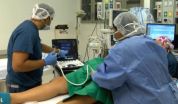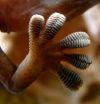(Press-News.org) VIDEO:
As many as 98 percent of all pediatric knee surgeries performed at Nationwide Children's Hospital were done in an outpatient setting, as a result of this method that reduces...
Click here for more information.
A recent study of an ultrasound-guided regional anesthesia technique, called femoral nerve block, shows that it leads to less opioid use and allows the majority of patients to go home within hours of surgery. As many as 98 percent of all pediatric knee surgeries performed at Nationwide Children's Hospital were done in an outpatient setting, as a result of this method that reduces post-operative pain and speeds recovery.
"Our goal with this technique is to reduce pain, which improves patient outcomes and patient satisfaction," said Tarun Bhalla, MD, director of Acute Pain and Regional Anesthesia at Nationwide Children's and a co-author of the study. "We also use fewer pain medicines intraoperatively as well as postoperatively, so we could really avoid a lot of the side effects that come along with them. We're localizing our numbing medicine to the area where the incision is being made to keep the coverage localized."
Anesthesiologists use ultrasound to guide a needle to the specific surgical site and deliver local anesthetic to numb only the nerves in that region. A femoral nerve block numbs the femoral nerve, which runs close to the femoral artery and conducts signals running along the front of the thigh, the inner leg and the foot. By numbing this nerve, all feeling to those regions is blocked. The anesthetic blocks pain for up to 12 hours in some cases, significantly reducing post-operative pain. Following surgery, patients have a catheter that runs to the surgical site. The catheter is connected to an exterior pump that delivers anesthetic to the area for up to three days after surgery, while the patient is at home.
The study also showed for patients who did require hospitalization spent fewer days inpatient as a result of ultrasound-guided regional anesthesia.
"With a significant reduction of inpatient stays, patients are going home within a couple hours after coming out of surgery and they have an easier recovery," Dr. Bhalla said. "I think the quality of recovery is much better because the patients are so much more comfortable at home and not surrounded by the sounds of hospital machines."
For the study, which was published in a recent issue of the Journal of Pediatric Orthopedics, researchers reviewed records of 376 patients age 7 to 18 years old who underwent arthroscopic knee surgery at Nationwide Children's between July 2008 and July 2011. Of these patients, 131 received a femoral nerve block in addition to general anesthesia, while 245 received general anesthesia alone. Patients who received the combined anesthesia reported less pain, required less pain medication after surgery and had shorter hospital stays when compared to patients who had general anesthesia alone. This includes 98 percent of ACL reconstructions, which are considered to be one of the most painful of all procedures evaluated in the study.
"It's a safe procedure that's markedly improved our ability to perform outpatient surgical services and in fact, it's become very rare for us to have any overnight stays for knee reconstruction," said Kevin E. Klingele, MD, chief of Orthopedics at Nationwide Children's and a co-author of the study.
While this study looked specifically at arthroscopic knee surgery, regional anesthesia is also becoming more widely used in orthopedic procedures in the shoulder, elbow and wrist and in other surgical procedures in the abdomen. Regional anesthesia is being used in cardiac and urological surgeries as well.
"Ultrasound-guided regional anesthesia is being used more regularly in pediatric patients, and more often in younger and younger patients," said Dr. Bhalla, also director of the Pediatric Regional Anesthesia fellowship at Nationwide Children's and a faculty member at The Ohio State University College of Medicine. "One of the most significant side effects of opioid use in infants is depressed respiratory function, which leads many infants to require intubation. Reducing the need for narcotics helps the infants come off ventilation more quickly."
Nationwide Children's is one of 13 medical centers nationwide participating in the Pediatric Regional Anesthesia Network, or PRAN, a collaboration designed to support the collection of highly audited data on practice patterns and complications and to facilitate collaborative research in regional anesthetic techniques in infants and children. Participating institutions report the number of regional anesthesia procedures they do each month.
"Since 2010, we have significantly increased the number of blocks we are doing and now perform 150 and 200 a month," said Dr. Bhalla, who travels around the country and the world teaching other medical centers how to do these procedures in pediatric patients. "Of course, it's reduced cost to patients and families, reduced cost to insurance companies. So, it really is a whole benefit for the community and improves the experience for our patients."
INFORMATION: END
Regional anesthesia for pediatric knee surgery reduces pain, speeds recovery
2014-08-12
ELSE PRESS RELEASES FROM THIS DATE:
Oxidative stress is significant predictor for hip fracture, research shows
2014-08-12
CINCINNATI—Oxidative stress is a significant predictor for hip fracture in postmenopausal women, according to new research led by University of Cincinnati (UC) epidemiologists.
The research, appearing online ahead of print in the Journal of Bone and Mineral Research, was led by Tianying Wu, MD, PhD, an assistant professor in the UC College of Medicine Department of Environmental Health, and Shuman Yang, a postdoctoral fellow in the department. They collaborated with researchers from the Harvard School of Public Health and Harvard Medical School.
"To our knowledge, this ...
Fires in Northern Washington State
2014-08-12
The Pacific Northwest has been inundated with wildfires most stemming from lightning strikes during summer storms. Four of these wildfires can be seen in this natural-color Aqua satellite image collected by the Moderate Resolution Imaging Spectroradiometer, MODIS, instrument aboard. This image was taken on August 11, 2014. Actively burning areas, detected by MODIS's thermal bands, are outlined in red.
The Upper Falls wildfire was started by a lightning strike on August 03. It is located 17 Miles North of Winthrop WA, 37 miles Northwest of Omak, WA and has grown to ...
NASA sees a weaker Tropical Storm Julio far north of Hawaii
2014-08-12
Tropical Storm Julio continues to weaken as it moves through cooler waters of the Central Pacific Ocean. NASA's Terra satellite passed over Julio and saw that the bulk of the clouds and precipitation were being pushed to the34 north of the center as the storm tracked far north of the Hawaiian Islands.
NASA's Terra satellite passed over Julio on August 11 at 21:25 UTC (5:25 p.m. EDT) and the Moderate Resolution Imaging Spectroradiometer or MODIS instrument aboard took a visible picture of the storm. The MODIS image revealed a circular center, but most of the clouds and ...
Copper foam turns carbon dioxide into useful chemicals
2014-08-12
PROVIDENCE, R.I. -- A catalyst made from a foamy form of copper has vastly different electrochemical properties from catalysts made with smooth copper in reactions involving carbon dioxide, a new study shows. The research, by scientists in Brown University's Center for the Capture and Conversion of CO2, suggests that copper foams could provide a new way of converting excess CO2 into useful industrial chemicals.
The research is published in the journal ACS Catalysis.
As levels of carbon dioxide in the atmosphere continue to rise, researchers are looking for ways to make ...
Geckos use toe hairs to turn stickiness on/off
2014-08-12
WASHINGTON D.C. Aug. 12, 2014 -- If you've ever spent any time watching a gecko, you may have wondered about their uncanny ability to adhere to any surface -- including upside down on ceilings. It turns out the little lizards can turn the "stickiness" of toe hairs on the bottom of their feet on and off, which enables them to run at great speeds or even cling to ceilings without expending much energy.
In the Journal of Applied Physics, from AIP Publishing, Oregon State University (OSU) researchers describe their work exploring the subtleties of geckos' adhesion system ...
No excess baggage: Antarctic insect's genome, newly sequenced, is smallest to date
2014-08-12
COLUMBUS, Ohio – Scientists who sequenced the genome of the Antarctic midge suspect the genome's small size – the smallest in insects described to date – can probably be explained by the midge's adaptation to its extreme living environment.
The midge is a small, wingless fly that spends most of its two-year larval stage frozen in the Antarctic ice. Upon adulthood, the insects spend seven to 10 days mating and laying eggs, and then they die.
Its genome contains only 99 million base pairs of nucleotides, making it smaller than other tiny reported genomes for the body ...
Scientists discover the miracle of how geckos move, cling to ceilings
2014-08-12
CORVALLIS, Ore. – Researchers at Oregon State University have developed a model that explains how geckos, as well as spiders and some insects, can run up and down walls, cling to ceilings, and seemingly defy gravity with such effortless grace.
The solution, outlined today in the Journal of Applied Physics, is a remarkable mechanism in the toes of geckos that use tiny, branched hairs called "seta" that can instantly turn their stickiness on and off, and even "unstick" their feet without using any energy.
These extraordinary hairs contribute to the ability of geckos to ...
WSU researcher sees survival story in Antarctic fly's small genome
2014-08-12
PULLMAN, Wash.—Few animals can boast of being as tough as the Antarctic midge. Its larvae develop over not one but two Antarctic winters, losing nearly half their body mass each time. It endures high winds, salt, and intense ultraviolet radiation. As an adult, the midge gets by without wings and lives for only a week or so before starting its life cycle all over again.
And as Joanna Kelley has learned, it does this with the smallest insect genome sequenced so far.
"It's tiny," said Kelley, a Washington State University assistant professor, who recently sequenced and analyzed ...
Transgender relationships undermined by stigma
2014-08-12
PROVIDENCE, R.I. — Researchers who looked at the impact of discrimination, poverty and stigma on the mental health and relationship quality of transgender women and their male romantic partners found that social and economic marginalization not only takes a psychological toll on each person individually but also appears to undermine them as a couple.
It is difficult to be a transgender woman in the United States. Prior research has shown that they generally face high risks of depression, financial hardship, and discrimination, said study lead author Kristi Gamarel, a ...
Majority of Quebec children placed in out-of-home care are reunited with their family
2014-08-12
The majority of children in Quebec's youth protection system who are placed in out-of-home care (family foster care, or in a group or rehabilitation centre) are reunited with their "natural" families within 6 months, according to a study led by Professor Tonino Esposito of University of Montreal's School of Social Work. However, younger children, specifically those aged 2 to 5 years old at initial placement, have the lowest likelihood of returning to live with their natural families over time. "All placed children, irrespective of age, are less likely to return to live ...









